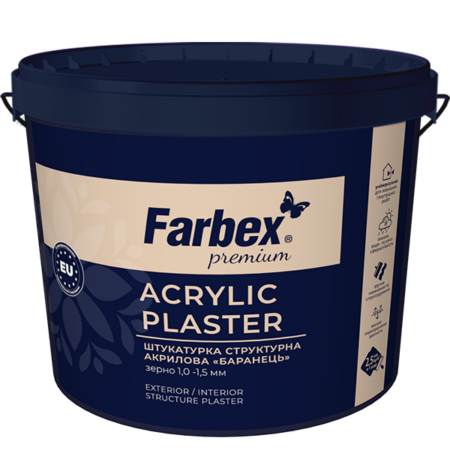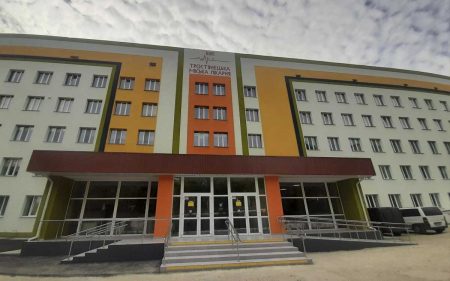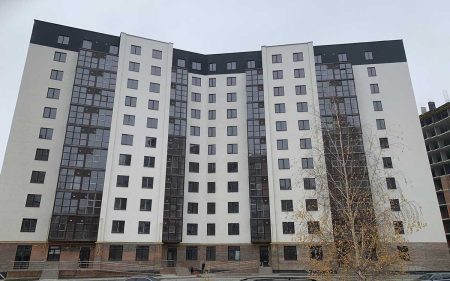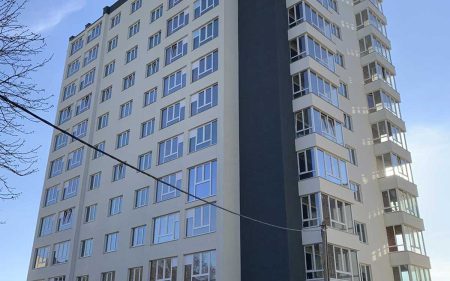
Farbex
Штукатурка структурна акрилова «Баранець»
розмір зерна 1,0-1,5 мм
Specification
It is ready to use. It creates a weather-resistant coating with low water permeability, resistance to mechanic load and aggressive nature affects. It is vapor permeable, flexible, has high adhesion to many kinds of surfaces. It can cover small cracks. It is easy to use and to form a structure.
Sphere of application
It is intended for finishing coating with "lamb" structure on porous and gas concrete surfaces, mineral stuccos, gypsum panels, concrete, gypsum surfaces, insulating systems, walls made of stone, asbestos cement indoors and outdoors. It is recommended for coating of the surfaces with high operation load and for insulation systems of facades.
Tinting
It can be tinted manually with Pigment Concentrate Farbex Color, other waterborne coloring pastes or with a coloring machine acc. to NCS color range and others.
Content
Technical data
| Consumption standard of 1 layer | 2,5-2,9 kg/m2 |
| Thinner | Water. It is allowed to dilute it max. 1% of the total weght of the product. |
| Application | Apply with a stainless trowel, form structure with a plastic trowel.. It is allowed to apply with applying machine. |
| Drying period (23 °С, 50% RH) | ab. 2 hours ("tack free"). The surface shall not be affected with precipitation or sub-zero temperature during 24 hours. Complete drying of the surface is in 3 days.. Drying period increases when the temperature is getting down and relative air humidity increasing |
| Solids content (DSTU ISO 3251) | 83±2 % |
| Density (DSTU ISO 2811-1) | ≈ 1,93 g/cm3 |
| Gloss (DSTU ISO 2813) | Not defined, not defined, G0, DSTU EN 1062-1) |
| Dry film thickness | Meets grain-size of ≈ 1,5 mm, for single layer of coat (> 400 microns, E5, DSTU EN 1062-1) |
| Particle size | maximum 1500 microns, (hard-grained, < 1500 microns, S3, DSTU EN 1062-1) |
| Vapor permeability (EN ISO 7783-2) | more than 100 g/(m2*day), (medium, >15 - ≤150 g/(m2*day), V2, DSTU EN 1062-1) |
| Water permeability (DSTU EN 1062-3) | maximum 0,1 kg/(m2*h0,5), (low, < 0,1 kg/(m2*h0,5), W3, DSTU EN 1062-1) |
| Marking acc. to the DSTU EN 1062-1 | G0|E5|S3|V2|W3|A0|C0 |
| Non-volatile matter by volume (DSTU ISO 3233) |
67±2 % |
| VOC content (ISO 11890) | < 60 g/l. |
| Warranty period | 18 months, (at the temperature from +5 °С till +35 °С) |
| Packaging | 18 kg, 30 kg |
Color
Application instruction
-
1. Preliminary preparation
Uncoated surfaces: Clean thoroughly from fragile coatings, dust, oil, grease, and other dirt. New stucco coatings shall not be treated before 2-4 weeks.
Previously coated surfaces: clean the surface thoroughly from old loose coatings (loose paint or varnish) mechanically (a scraper, a wire brush), thermally (hot air dryer, infrared radiation) or chemically (paint removing products). The surface shall be also cleaned of all kinds of dirt. Surfaces previously coated with alkyd or oily enamels shall be sandpapered then apply adhesive primer "Beton-kontakt" TM Farbex. Then treat the surface as an uncoated surface.
Correct non-significant defects of mineral surfaces with Finishing Putty TM Farbex and then sandpaper.
It is recommended to treat the surface with Antiseptic TM Farbex for protection against mould and fungi.
2. Priming
Very absorbing surfaces shall be treated with deep penetrating silicone primer TM Farbex.
Apply obligatory a coat of paint primer with quartz filler TM Farbex. Paint primer shall be tinted in the color of decorative stucco.
Apply a coat of adhesive primer "Beton-kontakt" TM Farbex for difficult base surfaces (see the sphere of application). Adhesive primer shall be tinted in the color of decorative stucco.
3. Applying
Stir thoroughly before use.
The product shall be applied on the surface in 1 layer with a stainless trowel or an appropriate machine for the application. Remove the extra product from the surface right after application making the grain-size thickness layer. Form a structure in 3-5 minutes with a plastic trowel. In accordance with the direction of the tool move (vertical, horizontal or circle like, etc.) different structures of the "bark beetle" are achieved. The time between stucco application and its structuring can vary depending on the temperature and air humidity, the temperature of a base surface, degree of its water absorption and the body of the product.
If the application is performed manually there shall be two persons as the work on one flat area shall be performed constantly with the "wet to wet" method. The structure of the surface shall be formed with the same instrument on the whole surface. Don't let the edge of the applied product getting dry.
When the product is applied with a machine, its nozzle shall be chosen exactly in accordance with the grain size (nozzle size shall have a diameter of 4 grains). Required working pressure shall be 0.3 - 0.4 MPa (3-4 bar).
The temperature of air and the surface under application shall be from +5 ° С till +30 ° С, maximal relative air humidity shall be 80%.
Do not apply stucco under direct sunlight, strong wind, frost and precipitation.
4. Tool cleaning
Clean tools with water after application. Do not let them dry. Dry product shall be removed from the tools in mechanical way.
References

Для роботи з фасадом були використані продукти Farbex: фарба-ґрунт універсальна з кварцовим наповнювачем, колір NCS …

Для оздоблення фасаду використовували декоративну акрилову штукатуркою “Баранець” Farbex заколорованої у кольори NCS S 3060-G70Y, …

Фасад оздоблено декоративною акриловою штукатуркою "Баранець" Farbex заколорованої у кольори NCS S 0500-N та NCS …
Acrylic plasters Farbex
Acrylic plastersповністю
Flow calculator
Consumption standard of 1 layer
When calculating the area to be painted, you need to subtract the area that will not be painted. (windows, doors, etc.)
Paint consumption may vary depending on dilution and uniformity of application of the paint.
